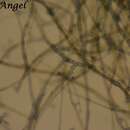fi
nimet breadcrumb-navigoinnissa


Els Ceratobasidiaceae són una família de fongs. Totes les seves espècies tenen basidiocarps (cossos fructífers) menuts. Moltes espècies són saprotròfiques però algunes són patògens facultatius de les plantes o estan associades amb micoriza en les orquídies. Gèneres amb importància econòmica inclouen Ceratobasidium i Thanatephorus (anamorf Rhizoctonia), que causen malalties a les plantes.
El 1981 Jülich creà l'ordre Ceratobasidiales per acomodar aquesta família. El 1995, l'ordre i la família tenien 18 gèneres, incloent Ceratobasidium, Heteroacanthella, Oliveonia, Scotomyces, Thanatephorus, i els seus diveroso sinònims i anamorfs.[1]
Ceratobasidiaceae, segons la cladística, no pertany a un ordre separat sinó que són part dels Cantharellales.[2] Els gèneres Heteroacanthella i Oliveonia no estan estretament relacionats amb els Ceratobasidiaceae, però han estat ubicats a Auriculariales.[3]
Les espècies són principalment saprotròfics, que es troben en l'èdafon (sòl) i produeixen els seus cossos fructífers en tiges mortes i detritus de les plantes. Alguns es troben en fulles i tiges vives. Diverses espècies s'han aïllat en la micoriza de les orquídies o en conreus malalts o la gespa. Tenen distribució cosmopolita.[4]
Els Ceratobasidiaceae són una família de fongs. Totes les seves espècies tenen basidiocarps (cossos fructífers) menuts. Moltes espècies són saprotròfiques però algunes són patògens facultatius de les plantes o estan associades amb micoriza en les orquídies. Gèneres amb importància econòmica inclouen Ceratobasidium i Thanatephorus (anamorf Rhizoctonia), que causen malalties a les plantes.
The Ceratobasidiaceae are a family of fungi in the order Cantharellales. All species within the family have basidiocarps (fruit bodies) that are thin and effused. They have sometimes been included within the corticioid fungi or alternatively within the "heterobasidiomycetes". Species are saprotrophic, but some are also facultative plant pathogens or are associated with orchid mycorrhiza. Genera of economic importance include Ceratobasidium and Rhizoctonia, both of which contain plant pathogenic species causing diseases of commercial crops and turf grass.
The family was created in 1948 by American mycologist G.W. Martin to accommodate species of corticioid fungi with heterobasidiomycete features (elongated sterigmata and basidiospores that give rise to secondary spores). He restricted the Ceratobasidiaceae to the genus Ceratobasidium, though including within the genus species later placed in Thanatephorus and Oliveonia.[1] In 1981, Jülich created the order Ceratobasidiales to accommodate the family. By 1995, the order and the family contained 18 genera, including Ceratobasidium, Heteroacanthella, Oliveonia, Scotomyces, Thanatephorus, and their various synonyms and anamorphs.[2]
Molecular research, based on cladistic analysis of DNA sequences, has now shown that the Ceratobasidiaceae do not belong to a separate order, but are part of the Cantharellales.[3] The genera Heteroacanthella and Oliveonia are not closely related to the Ceratobasidiaceae, but have been placed in the Auriculariales.[4] No species of the genus Scotomyces has yet been sequenced.
Following changes to the International Code of Nomenclature for algae, fungi, and plants, the practice of giving different names to teleomorph and anamorph forms of the same fungus was discontinued, meaning that Thanatephorus became a synonym of the earlier name Rhizoctonia, previously used for anamorphic species. DNA evidence also placed most, if not all, Ceratobasidium species in Rhizoctonia.[5]
Research on the septal pore ultrastructure of the little-known and atypical type species of Ceratobasidium, C. calosporum, indicates that it is a member of the Auriculariales and is unrelated to other species of Ceratobasidium.[3][6] Technically, this means that the Ceratobasidiaceae belong within the Auriculariales, but this is a taxonomic problem that has yet to be resolved.[7]
Species are mainly saprotrophic, occurring in the soil and producing fruit bodies on dead stems and plant detritus. Some occur on attached leaves and stems. Several species have been isolated from orchid mycorrhiza or from diseased crops and turf grass. Distribution appears to be cosmopolitan.[8]
Several species of Ceratobasidium and Rhizoctonia are opportunistic parasites of plants, causing a variety of economically important diseases of crops.[8]
{{cite journal}}: CS1 maint: multiple names: authors list (link) The Ceratobasidiaceae are a family of fungi in the order Cantharellales. All species within the family have basidiocarps (fruit bodies) that are thin and effused. They have sometimes been included within the corticioid fungi or alternatively within the "heterobasidiomycetes". Species are saprotrophic, but some are also facultative plant pathogens or are associated with orchid mycorrhiza. Genera of economic importance include Ceratobasidium and Rhizoctonia, both of which contain plant pathogenic species causing diseases of commercial crops and turf grass.
Les Ceratobasidiaceae constituent une famille de champignons basidiomycètes de l'ordre des Agaricales.
Selon NCBI (23 novembre 2014)[1] :
Les Ceratobasidiaceae constituent une famille de champignons basidiomycètes de l'ordre des Agaricales.
Podstawkorożkowate (Ceratobasidiaceae G.W. Martin) – rodzina grzybów znajdująca się w rzędzie pieprznikowców (Cantharellales)[2].
Pozycja w klasyfikacji według Index Fungorum: Cantharellales, Incertae sedis, Agaricomycetes, Agaricomycotina, Basidiomycota, Fungi[1].
Polskie nazwy na podstawie pracy Władysława Wojewody z 2003 r[3].
Podstawkorożkowate (Ceratobasidiaceae G.W. Martin) – rodzina grzybów znajdująca się w rzędzie pieprznikowców (Cantharellales).
Ceratobasidiaceae é uma família de fungos pertencente à família Ceratobasidiaceae.[1][2]
Ceratobasidiaceae é uma família de fungos pertencente à família Ceratobasidiaceae.